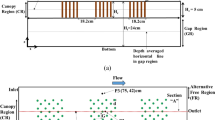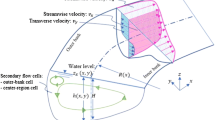Abstract
The current work presents a two-dimensional (2D) unsteady suspended sediment transport model for an open channel turbulent flow. Unlike most of the existing similar works in literature who describes either the spatial change or the temporal change in concentration along with vertical distribution, the present study describes spatial, temporal and vertical variation of concentration together. The model is developed from the mixing length point of view, which is an important feature of turbulent flow. It also incorporates the effect of hindered settling velocity of a sediment particle resulting from the presence of other particles in the flow. The developed non-linear partial differential equation together with the most realistic boundary condition has been solved numerically. The findings indicate that the suspension region experiences a decrease in concentration value far from downstream as a result of the modified mixing length of sediment-laden flow and opposite is the case for the hindered settling velocity at any downstream position. Over all, a reduction in the concentration value occurs in the suspension due to the inclusion of these two effects. Also, the hindered settling increases the magnitude of the bottom concentration and the damping factor of mixing length decreases the magnitude of the bottom concentration both the effects being very small. The model has been validated with laboratory data under specified conditions.













Similar content being viewed by others
Data availability
The data that support the findings of this study are available.
Code availability
We have created the programming code.
References
Rouse H (1937) Modern conceptions of the mechanics of fluid turbulence. Trans Am Soc Civ Eng 102(1):463–505
Hunt J (1954) The turbulent transport of suspended sediment in open channels. Proc R Soc London Ser A Math Phys Sci 224(1158):322–335
Lyn D (1988) A similarity approach to turbulent sediment-laden flows in open channels. J Fluid Mech 193:1–26
Kovacs A (1998) Prandtl’s mixing length concept modified for equilibrium sediment-laden flows. J Hydraul Eng 124(8):803–812
Kundu S, Ghoshal K (2014) Effects of secondary current and stratification on suspension concentration in an open channel flow. Environ Fluid Mech 14:1357–1380
Ali SZ, Dey S (2016) Mechanics of advection of suspended particles in turbulent flow. Proc R Soc A Math Phys Eng Sci 472(2195):20160749
Cantero-Chinchilla FN, Castro-Orgaz O, Dey S (2016) Distribution of suspended sediment concentration in wide sediment-laden streams: a novel power-law theory. Sedimentology 63(6):1620–1633
Kumbhakar M, Saha J, Ghoshal K, Kumar J, Singh VP (2018) Vertical sediment concentration distribution in high-concentrated flows: An analytical solution using homotopy analysis method. Commun Theor Phys 70(3):367
Mei C (1969) Nonuniform diffusion of suspended sediment. J Hydraul Div 95(1):581–584
Hjelmfelt A, Lenau C (1970) Nonequilibrium transport of suspended sediment. J Hydraul Div 96(7):1567–1586
Galappatti G, Vreugdenhil C (1985) A depth-integrated model for suspended sediment transport. J Hydraul Res 23(4):359–377
Wang Z (1992) Theoretical analysis on depth-integrated modelling of suspended sediment transport. J Hydraul Res 30(3):403–421
Bolla Pittaluga M, Seminara G (2003) Depth-integrated modeling of suspended sediment transport. Water Resour Res. https://doi.org/10.1029/2002WR001306
Monin A (1959) On the boundary condition on the earth surface for diffusing pollution. Adv Geophys 6:435–436
Calder K (1961) Atmospheric diffusion of particulate material, considered as a boundary value problem. J Atmos Sci 18(3):413–415
Dobbins W (1944) Effect of turbulence on sedimentation. Trans Am Soc Civ Eng 109(1):629–656
Cheng K (1984) Bottom-boundary condition for nonequilibrium transport of sediment. J Geophys Res Oceans 89(C5):8209–8214
Liu X, Nayamatullah M (2014) Semianalytical solutions for one-dimensional unsteady nonequilibrium suspended sediment transport in channels with arbitrary eddy viscosity distributions and realistic boundary conditions. J Hydraul Eng 140(5):04014011
Liu X (2016) Analytical solutions for steady two-dimensional suspended sediment transport in channels with arbitrary advection velocity and eddy diffusivity distributions. J Hydraul Res 54(4):389–398
Kundu S (2022) Study of unsteady nonequilibrium stratified suspended sediment distribution in open-channel turbulent flows using shifted chebyshev polynomials. ISH J Hydraul Eng 28(1):42–52
Richardson J (1954) Sedimentation and fluidisation: Part i. Trans Inst Chem Eng 32:35–53
Woo H, Julien P, Richardson E (1988) Suspension of large concentrations of sands. J Hydraul Eng 114(8):888–898
Mazumder B (1994) Grain size distribution in suspension from bed materials. Sedimentology 41(2):271–277
Baldock T, Tomkins M, Nielsen P, Hughes M (2004) Settling velocity of sediments at high concentrations. Coast Eng 51(1):91–100
Pal D, Ghoshal K (2017) Hydrodynamic interaction in suspended sediment distribution of open channel turbulent flow. Appl Math Model 49:630–646
Absi R (2010) Concentration profiles for fine and coarse sediments suspended by waves over ripples: an analytical study with the 1-dv gradient diffusion model. Adv Water Resour 33(4):411–418
Jain P, Ghoshal K (2021) Closed form solution of vertical concentration distribution equation: revisited with homotopy perturbation method. J Theor Appl Mech 52(3):277–300
Jain P, Kumbhakar M, Ghoshal K (2021) Application of homotopy analysis method to the determination of vertical sediment concentration distribution with shear-induced diffusivity. Eng Comput 38:260
Jing H, Chen G, Wang W, Li G (2018) Effects of concentration-dependent settling velocity on non-equilibrium transport of suspended sediment. Environ Earth Sci 77(15):1–10
Mohan S, Kumbhakar M, Ghoshal K, Kumar J (2020) Semi-analytical solution for one-dimensional unsteady sediment transport model in open channel with concentration-dependent settling velocity. Phys Scr 95(5):055204
Kumbhakar M, Mohan S, Ghoshal K, Kumar J, Singh V (2022) Semianalytical solution for nonequilibrium suspended sediment transport in open channels with concentration-dependent settling velocity. J Hydrol Eng 27(2):04021048
Prandtl L (1933) Recent results of turbulence research. Technical report
Umeyama M, Gerritsen F (1992) Velocity distribution in uniform sediment-laden flow. J Hydraul Eng 118(2):229–245
Umeyama M (1992) Vertical distribution of suspended sediment in uniform open channel flow. J Hydraul Eng 118(6):936–941
Ghoshal K, Jain P, Absi R (2022) Nonlinear partial differential equation for unsteady vertical distribution of suspended sediments in open channel flows: effects of hindered settling and concentration-dependent mixing length. J Eng Mech 148(1):04021123
Hossain S, Singh G, Dhar A, Ghoshal K (2022) Generalized non-equilibrium suspended sediment transport model with hindered settling effect for open channel flows. J Hydrol 612:128145
Huai W, Yang L, Guo Y (2020) Analytical solution of suspended sediment concentration profile: relevance of dispersive flow term in vegetated channels. Water Resour Res 56(7):2019–027012
Batchelor G (1972) Sedimentation in a dilute dispersion of spheres. J Fluid Mech 52(2):245–268
Cheng N (1997) Simplified settling velocity formula for sediment particle. J Hydraul Eng 123(2):149–152
Montes Videla JS (1973) Interaction of two dimensional turbulent flow with suspended particles. PhD thesis, Massachusetts Institute of Technology
Castro-Orgaz O, Giráldez JV, Mateos L, Dey S (2012) Is the von kármán constant affected by sediment suspension? J Geophys Res Earth Surface. https://doi.org/10.1029/2011JF002211
Lee D, Lick W, Kang S (1981) The entrainment and deposition of fine-grained sediments in lake erie. J Great Lakes Res 7(3):224–233
Herrmann J (2004) Effect of startification due to suspended sediment on velocity and concentration distribution in turbulent flows. Ph.D. thesis, Dept. of Civil and Environmental Engineering, Massachusetts Institute of Technology, Cambridge
Jobson HE, Sayre WW (1970) Vertical transfer in open channel flow. J Hydraul Div 96(3):703–724
Celik I, Rodi W (1988) Modeling suspended sediment transport in nonequilibrium situations. J Hydraul Eng 114(10):1157–1191
Sen S, Kundu S, Absi R, Ghoshal K (2023) A model for coupled fluid velocity and suspended sediment concentration in an unsteady stratified turbulent flow through an open channel. J Eng Mech 149(1):04022088
Coleman N (1981) Velocity profiles with suspended sediment. J Hydraul Res 19(3):211–229
Vanoni V (1946) Transportation of suspended sediment by water. Trans Am Soc Civ Eng 111(1):67–102
Einstein H, Chien N (1955) Effects of heavy sediment concentration near the bed on velocity and sediment distribution. mrd sediment series no. 8. Univ of California, Berkeley, US Army Corps of Engineers, Missouri Div
Funding
The Council of Scientific and Industrial Research (CSIR) provides financial assistance.
Author information
Authors and Affiliations
Contributions
Authors have equally contributed for this work.
Corresponding author
Ethics declarations
Conflict of interest
There is no conflict of interest.
Consent for publication
Consent was received from all the authors.
Additional information
Publisher's Note
Springer Nature remains neutral with regard to jurisdictional claims in published maps and institutional affiliations.
Rights and permissions
Springer Nature or its licensor (e.g. a society or other partner) holds exclusive rights to this article under a publishing agreement with the author(s) or other rightsholder(s); author self-archiving of the accepted manuscript version of this article is solely governed by the terms of such publishing agreement and applicable law.
About this article
Cite this article
Kumar, A., Sen, S., Hossain, S. et al. Unsteady two-dimensional distribution of suspended sediment transport in open channels. Environ Fluid Mech (2023). https://doi.org/10.1007/s10652-023-09933-1
Received:
Accepted:
Published:
DOI: https://doi.org/10.1007/s10652-023-09933-1




